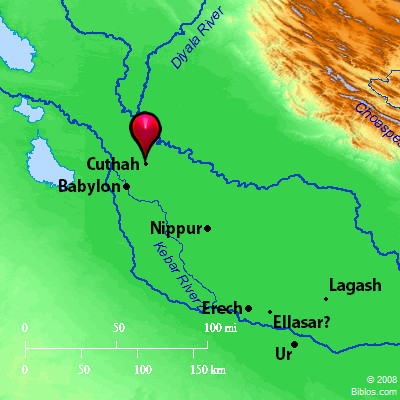Atlas  Cuthah and surrounding area
Maps Created using Biblemapper 3.0Additional data from OpenBible.info
You are free to use up to 50 Biblos coprighted maps (small or large) for your website or presentation. Please credit Biblos.com. Occurrences 2 Kings 17:24 The king of Assyria brought men from Babylon, and from Cuthah, and from Avva, and from Hamath and Sepharvaim, and placed them in the cities of Samaria instead of the children of Israel; and they possessed Samaria, and lived in the cities of it. Encyclopedia CUTH; CUTHAHkuth, ku'-tha (kuth, kuthah; Choua, Chountha): The longer writing is the better of the two, and gives the Hebrew form of the name of one of the cities from which Sargon of Assyria brought colonists to fill the places of the Israelites which he deported from Samaria in 772 B.C. (2 Kings 17:24, 30). Probably in consequence of their predominating numbers, the inhabitants of Samaria in general were then called kuthiyim, or Cutbeans. 1. The Ruins of Cuthah:
From contract-tablets found at Tel-Ibrahim by the late Hormuzd Hassam, on which the ancient name of the place is given as Gudua or Kutu, it would seem that that is the site which has to be identified with the Biblical Cuthah. It lies to the Northeast of Babylon, and was one of the most important cities of the Babylonian empire. The explorer describes the ruins as being about 3,000 ft. in circumference and 280 ft. high, and adjoining them on the West lies a smaller mound, crowned with a sanctuary dedicated to Ibrahim (Abraham). From the nature of the ruins, Rassam came to the conclusion that the city was much more densely populated after the fall of Babylon than in earlier times. A portion of the ruins were in a very perfect state, and suggested an unfinished building.
2. The Temple:
The great temple of the city was called E-mes-lam, and was dedicated to Nergal (compare 2 Kings 17:30), one of whose names was Meslam-ta-ea. Both city and temple would seem to have been old Sumerian foundations, as the name Gudua and its later Sere form, Kutu, imply.
LITERATURE.
See Rassam, Asshur and the Land of Nimrod, 396, 409, and, for details of the worship of Nergal, PSBA, December, 1906, 203-18.
T. G. Pinches |
    |




